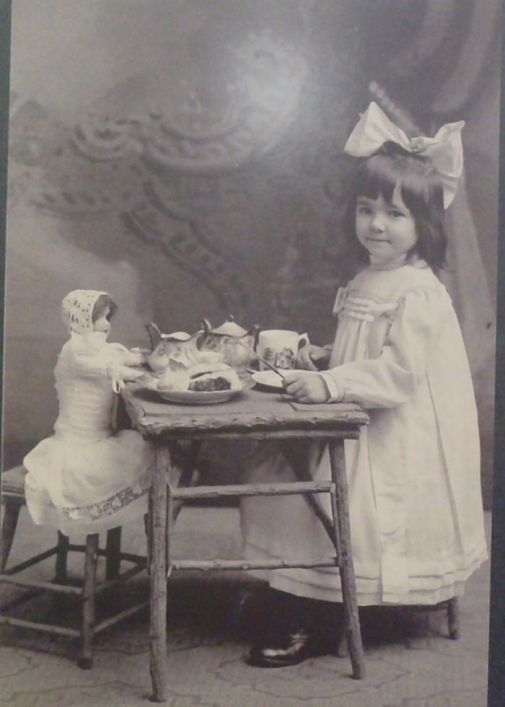
Little child-sized and toy dishes were made in abundance in England’s Staffordshire district potteries, especially throughout the 19th century. Staffordshire, which is a district of six towns on the western edge of England near Wales, was well suited to the pottery industry because of the ready availability of clay, salt, lead, and coal. As with Thuringia (Germany) being a center of toymaking before the advent of the china dolls made there, Staffordshire made pottery before the advent of porcelain. It was a center for pottery production since the early 17th century, noted for reddish brown wares. In 1720, potter John Astbury discovered that adding heated flint to the clay produced a more desirable lighter clay known as creamware. Soon after this discovery, beautiful English made pottery began to grace the tables of well-to-do families in England and America. Of course, modifications to the pottery continued to improve and add variations from soft paste or semi-porcelain, to ironstone and fine bone china.
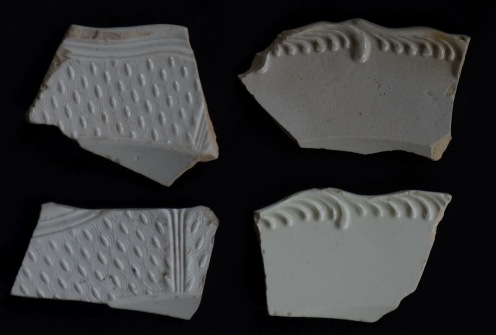
18th century creamware and feather edge shards
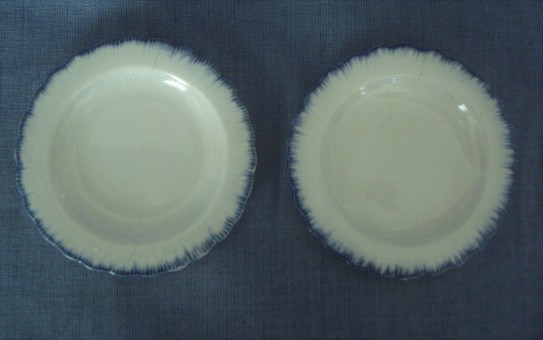
The two little 3″ Leeds feather edged plates, circa 1790-1800
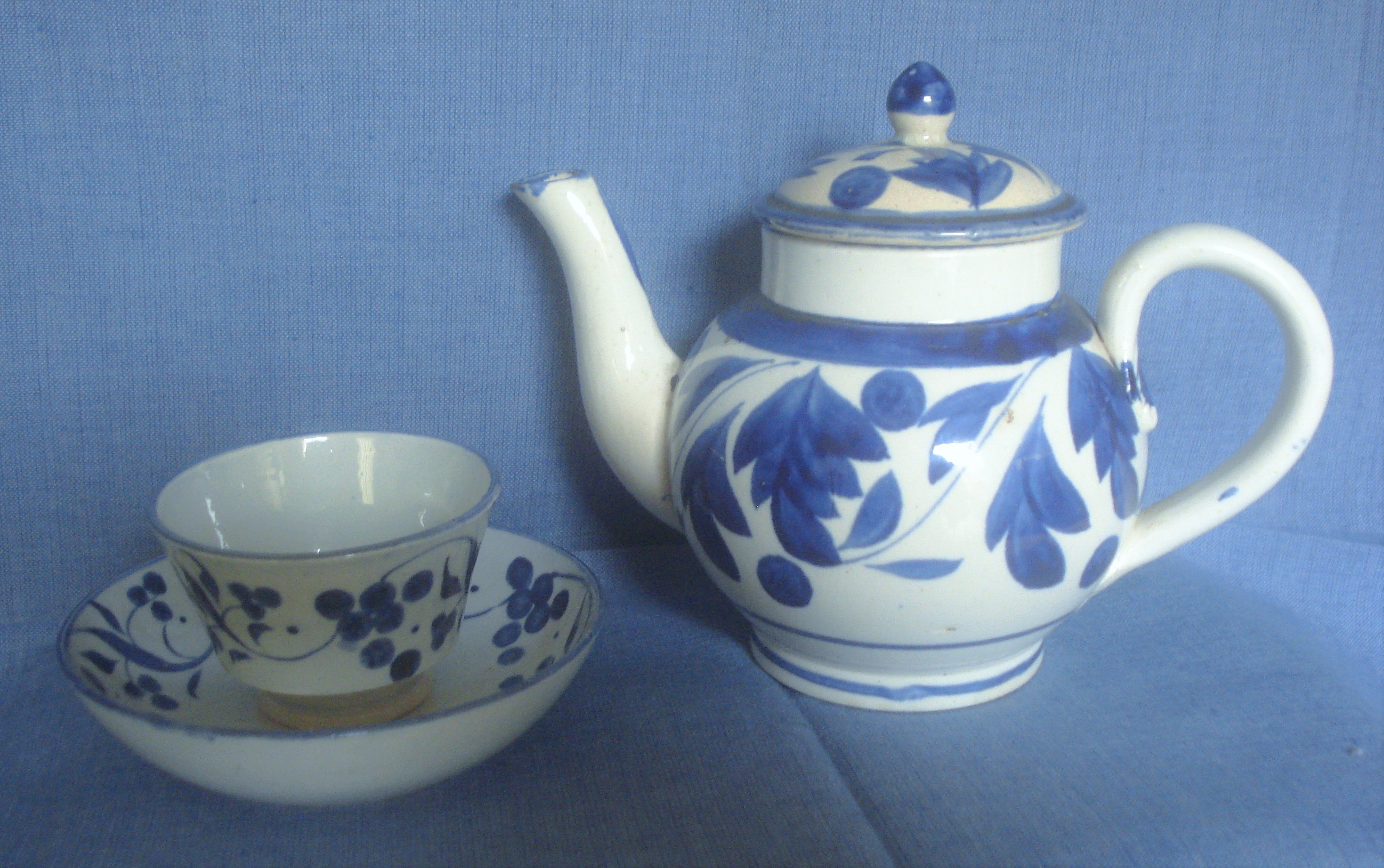
This tiny cup, saucer, and teapot are all hand painted. Though not part of the same set, the painting and color are similar enough on both that they display well together. The London style handleless cup and deep dish saucer date to 1810. The cup is only 1 5/8″ tall. The pot is pearlware dating to about 1820. It has the characteristic ball shape, raised rim, slightly curved spout, and plain handle of early English teapots. It is 4″ tall.
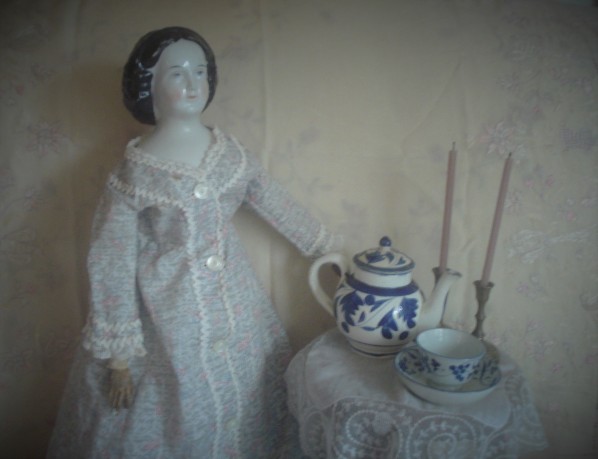
This photo shows the size of these little dishes, and how they display with an antique china doll. Moira is a stout 19″ tall. Her hair style is a molded snood. She is planning to have tea at home with no guests–she is wearing her morning dress with tiny waived braid (rickrack) trim.
Thanks to the Children
Children’s and toy dishes were made alongside those created for adults. The play dishes, then as now, were a whimsy that delighted adults as well as children. Dinner and tea sets were charming gifts for children from parents, grandparents, and adoring aunts and uncles. And so, we can thank these wealthy and merchant class children for the little dishes that have been cherished, and those that have made it through well preserved (or not), and passed down through time to become available to us, as admirers and collectors in our time.
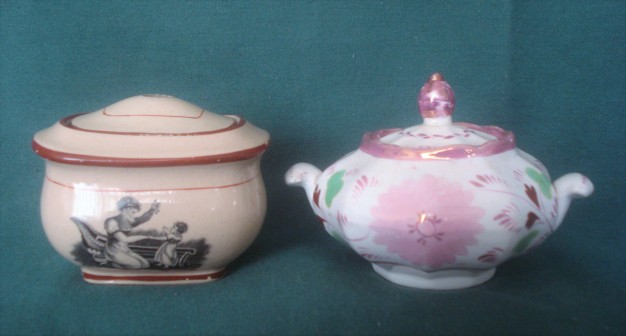
Two sugar boxes or bowls. First is a beige rectangular one with an Adam Buck transfer from about 1820. The lid is missing its finial, and is actually the matching teapot lid, which was the same size-it has a steam hole in the opposite side. Second is a circa 1835 hand painted bowl with pink luster trim. Both are small (doll sized) at about 2 1/2″ tall.
The poor children, though, deserve just as much, if not more, thanks for our little whimsies. Poor children have always had to work just as soon as their parents could find employment for them, and the Staffordshire potteries did offer employment for many children throughout the 19th century. Children as young as five or six years could fetch, carry, prepare raw materials, and provide power for the few machines that potters used. Many children at age eight to ten were working 72 hour weeks to the detriment of their health and education. At age 14, most children working in potteries became apprenticed to a particular trade-thrower, presser, transferer, or paintress. In 1840 Parliamentary inquiries were made into the state of children employed in mines and factories, leading to child labor laws.

Preparing plates for transfers which were applied on tissue paper
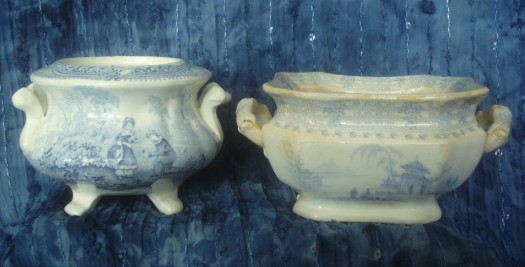
Two sugar bowls dating 1835-1840 have light blue transfers. The lids for both have not survived. These bowls without the lids measure 3″ tall by 4″ wide, and 2 1/2″ tall by 5″ wide.
To Teach, to Play, to Cherish
With so much to teach the young ones in the way of ettiquette, it was inevitable for child sized and toy tea and dinner sets to become more readily available. Children learned rituals and manners by having dinner or tea parties with their peers or by serving their dolls.
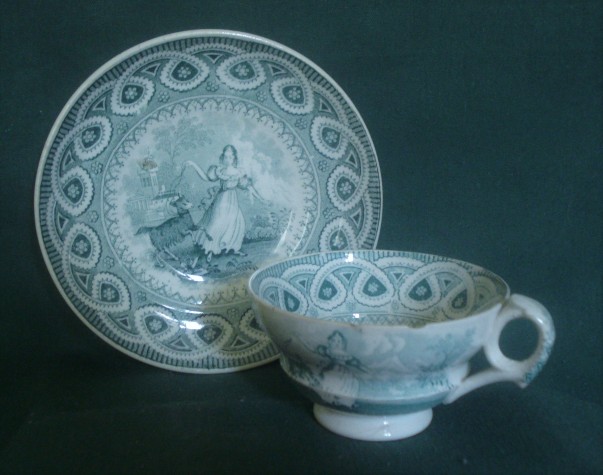
Girl with a Goat is a pattern dating 1860 to 1870. Notice the fancy handle on the cup. This transfer is a pleasant forest green. The set was also made in red and a lovely flow blue, and I saw one for sale in an amazing mulberry color. It is a child sized set with the saucer being 5″ in diameter.
The 1860’s marked the start of mass production of toy dishes. After this time, parents could be more generous with their children with gift giving. An 1890 Butler Brothers catalog is evidence that there were toy sets available for the taste and means of every family. Children’s tea sets were available in price from five cents to five dollars. By studying the quality of sets we find today, we can guess which ones were at which end of this spectrum!
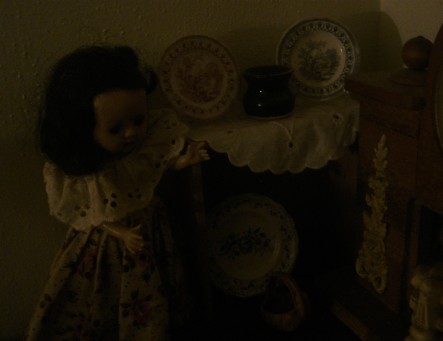
This doll “house” with the 8″ Ginny and Muffy dolls always photographs dark. You can see the two Fishers plates on their shelf. Barely over 2″ across, one is red and one is blue. Below is a slightly larger plate with a blue floral transfer.
Transferware became the decoration of choice for English pottery after its development in the second half of the 18th century. Early designs were based on Chinese designs, called Chinoiserie. Early transferware was blue because only underglaze cobalt blue could withstand the heat of the glost ovens. Lead oxide gave wares the characteristic depth of color that made them so successful.
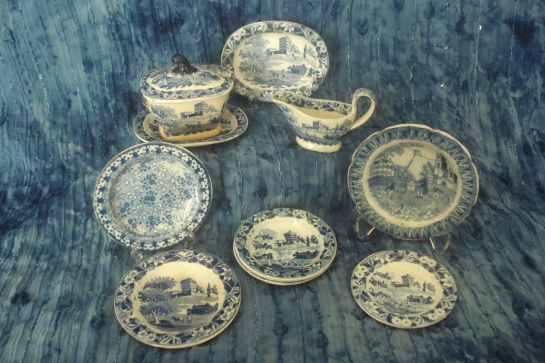
Examples of early blue transfers, circa 1830 to 1840. The Kite Flyer plate on the stand to the right is a favorite colonial scene. The other scenic transfer is Monastery on the Hill. The transfers on this pattern are often more clear, and it has a nice floral border. These are doll sized dishes. The little tureen is just 3″ across.
By 1800 some English scenes became available as transfer designs. After the Napoleonic Wars, in 1815, there was a trade boom and European scenes and subjects were in vogue. Pieces made for export to America were often very dark blue, and some had patriotic subjects.
Later developments allowed for other monochrome colors in transferware such as green, mild red known as puce, mulberry, black, and sepia or brown. Polychrome designs were made by adding painted colors over a transfer design.
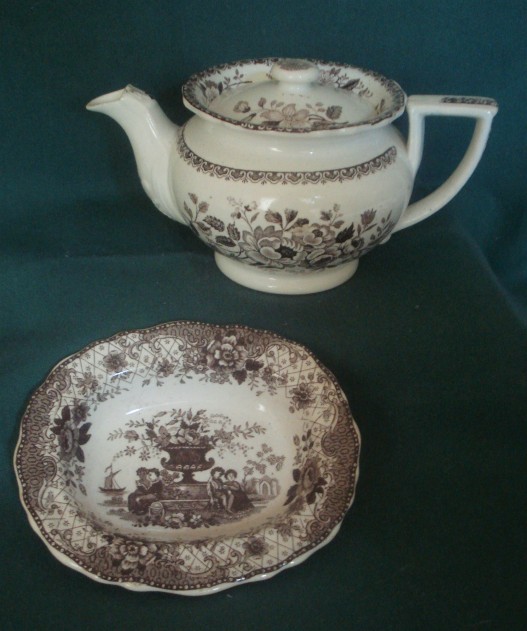
The sepia color Dresden Flowers teapot is circa 1830. It has a flanged rim with a well-fitting recessed lid. It is 2 5/8″ tall. The vegetable bowl, also in sepia, is Souveneir and dates 1830-1840. It is 4″ across. Both of these little treasures are perfect in the 1:4 scale doll house.
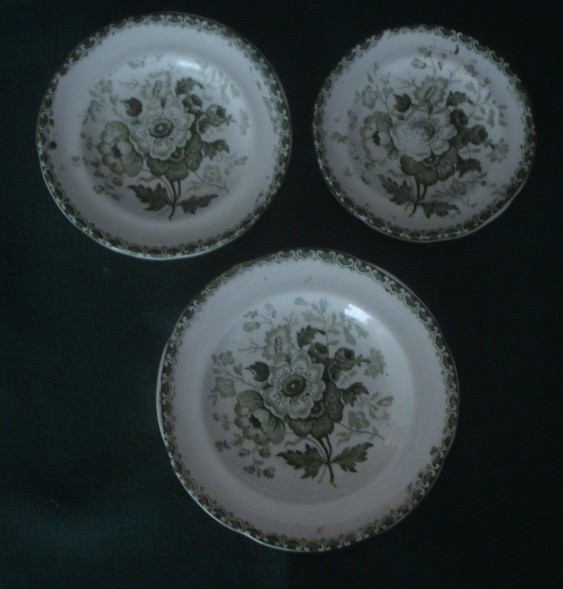
These plates in graduated sizes are also Dresden Flowers like the teapot above. This transfer is moss green, though this pattern has not been recorded as available in green. The largest plate measures 3 1/2″ in diameter.
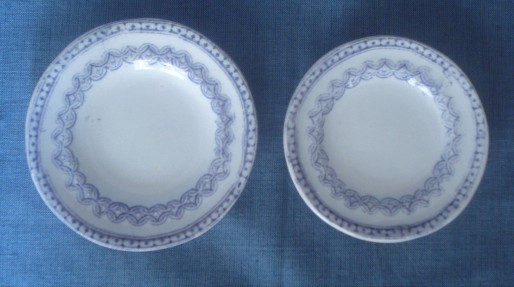
These soft paste plates are not a recorded pattern, though they have the characteristics of toy Staffordshire. 3″ and 3 1/4″
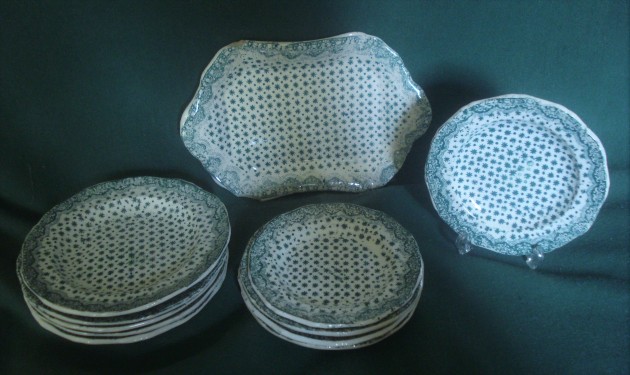
A desirable transferware sheet pattern in soft paste dating circa 1830’s, Dimity is found most often in blue. This green collection shows some breaks and blurring to the transfers, which is typical, as these were considered as play dishes and were meant to be inexpensive toys. Dimity has been found in puce, sepia, and black as well as blue and green.
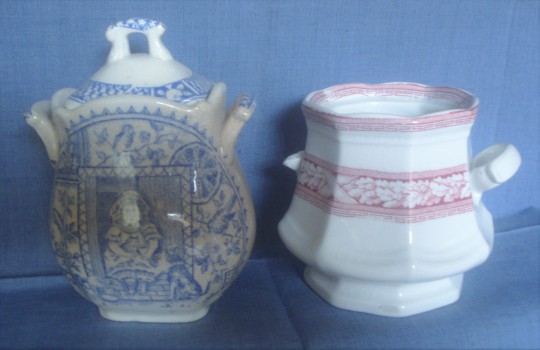
This blue May with Pets sugar pot (or biscuit jar) is from around 1880. It measures just under 5″ to the top of the lid. The other tall sugar pot shares a shape, or blank, with several documented tea sets from circa 1862. I have not found this red transfer of oak leaves and acorns in the reference books. This one has seen rough times with a broken handle and missing lid. It is 4″ tall without the lid.
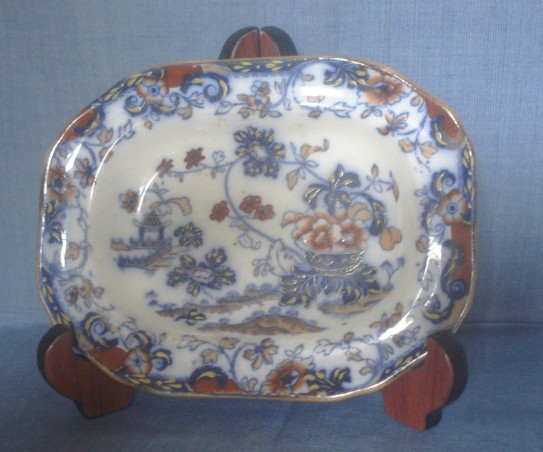
This pattern, a lovely example of transfer with hand painting and gold trim added, is called Amherst Japan. There is a child’s tea set in this pattern, circa 1854, but no mention of a child’s dinner set. This small tray may be a piece from a full size dinner set. It measures 6″ across.
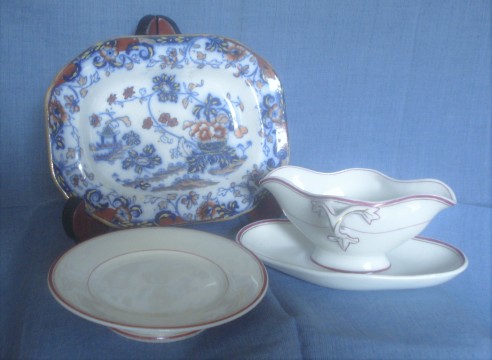
The Amherst Japan tray is the right size to be a serving piece in the 1:4 doll house. It is shown here with two pieces of the French set that is described below.
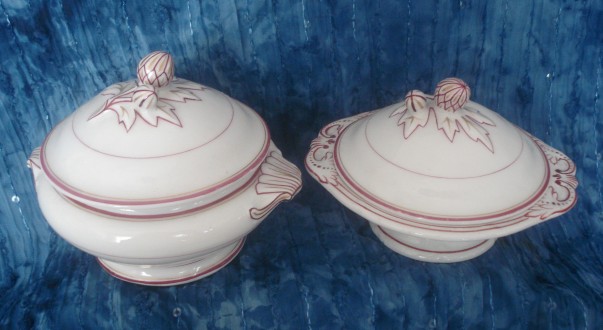
While Staffordshire is the place for children’s play dishes, there were lovely sets from other places as well. These tureens are part of a set made in France. The pottery, known as “Old Paris,” is very white, and the red and gold painted accents are quite detailed. The finials are two nobs that look like hops berries. The tureens date circa 1870-1880 and measure 5″ across.
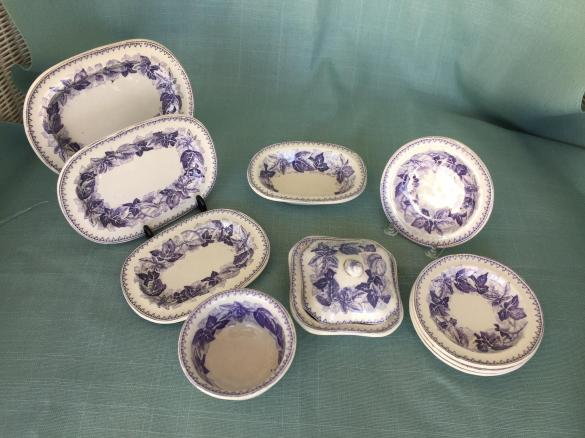
This lovely Lavender Leaf partial dinner set has recently joined my collection. I love how well made it is. The transfer pattern is clear and sharp, the deep lavender blue color is superb, and the little dishes are even and not too heavy. It dates to 1840-1850 and is doll sized. The square covered dish is just 2 3/4″ across.
For Your Pleasure and Continued Education
Staffordshire has been home to well known potteries such as Wedgwood, Copeland, and Ridgway, as well as to hundreds of small firms that have come and gone through the years. The variety and patterns available for antique toy Staffordshire dishes are too numerous to document–more are being discovered now, and several that I have shown you here are not in the reference books. The best reference books with color illustrations are Doris Lecher’s English Toy China, and Lorraine Punchard’s Playtime Pottery and Porcelain. Find them new and/or used from BN.com.
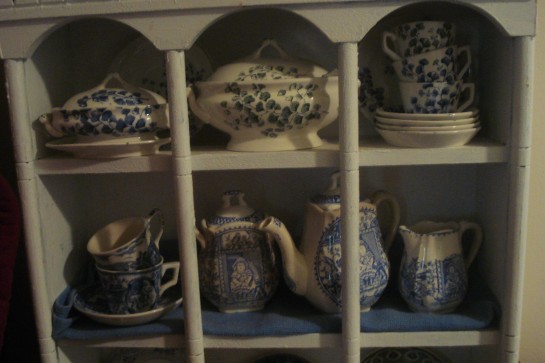
These two child sized collections are displayed in a small cabinet. The top shelf holds blue and green tureens, cups, saucers, and plates from the Maidenhair Fern collection. Below it is a tea set with the transfer known as May with Pets. The tall sugar pot with this set is also referred to as a biscuit jar. Both sets date to 1880-1890.
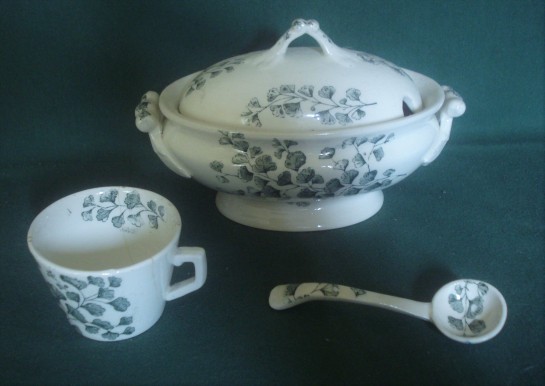
This is the large green Maidenhair Fern tureen. I especially like this find because it came with the pottery ladle! The ladles for dinner sets are rare because they were so easily broken. The tureen is 6 1/2″ long and the ladle measures 3 3/4″.
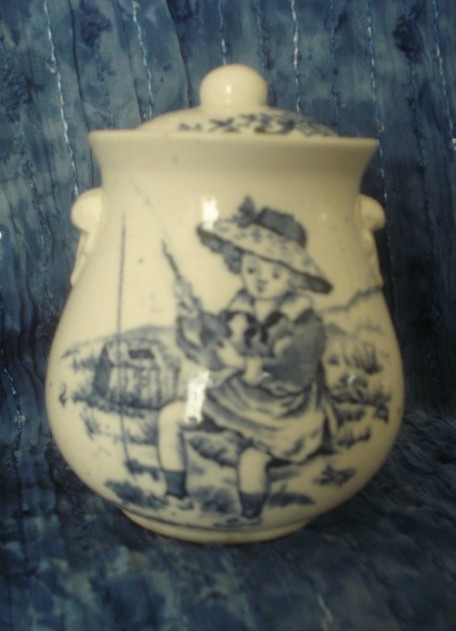
This darling sugar jar is from the Old Mother Hubbard collection, circa 1870 to 1890. It is 4″ tall. One reference claims this is English while the other says American made.
Living in the Pacific Northwest, I do not find toy Staffordshire at my local antique shops and sales. Luckily, it is fairly available on eBay and Ruby Lane, if one is not too discerning in searching for particular patterns and colors. When you are ready to shop for your own toy Staffordshire dishes, I highly recommend Nancy Barrister’s Ruby Lane shop, “Childhood Antiques.” She offers a good selection of antique children’s tea and dinner sets. Additionally, if your budget can only handle single pieces rather than sets, she has a good revolving selection on eBay at nbarrister. Nancy is a friendy and accomodating seller who provides professional packing for your treasures.
For a broader view of the scope of English toy china dishes, an observation of how they changed over the years, and more information on the makers of these pottery whimsies and their marks, I highly recommend two books:
- English Toy China by Doris Anderson Lechler. 1989; Antique Publications, Marietta, Ohio.
- Playtime Pottery & Porcelain from the United Kingdom & the United States by Lorraine Punchard. 1996; Schiffer Publishing Ltd, Atglen, PA.
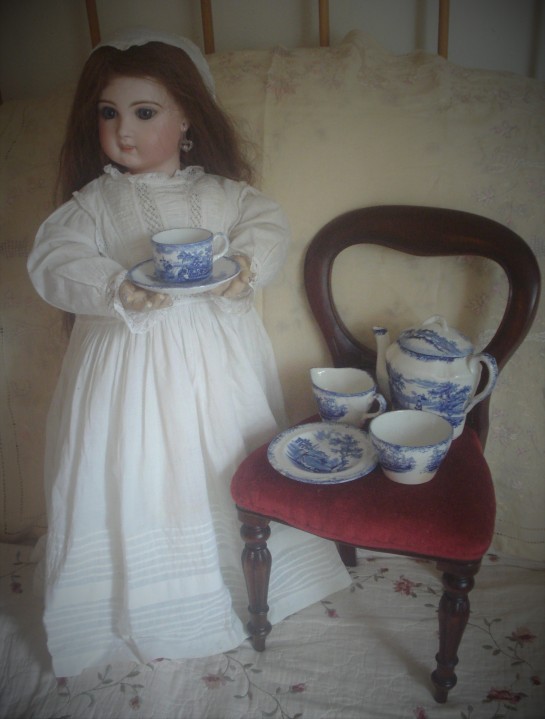
Miranda’s Humphrey’s Clock tea set is now complete. Here we have the last sugar bowl of our mystery grouping from Part 1 of this article, at circa 1900. It is open and intentionally has no lid. This sugar bowl is 2″ tall, while Miranda is 26″ tall.
Now that you are well on your way to appreciating Staffordshire children’s dishes, please come to tea and tell me about your observations and finds!
